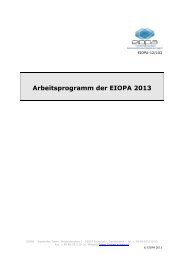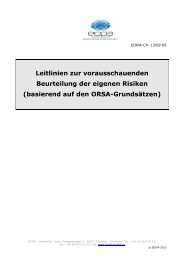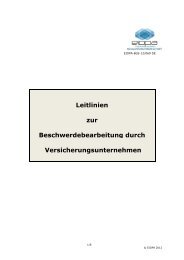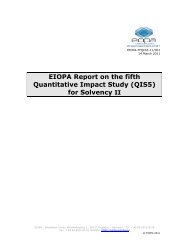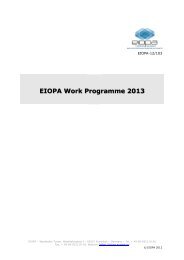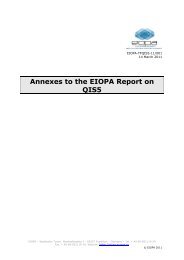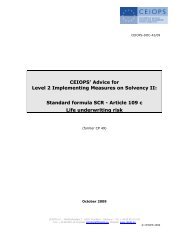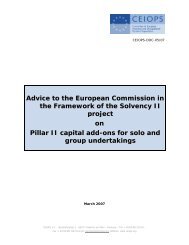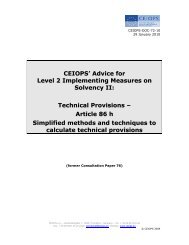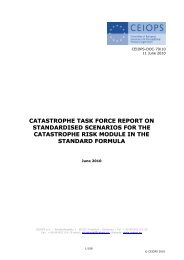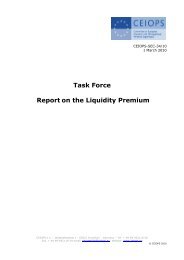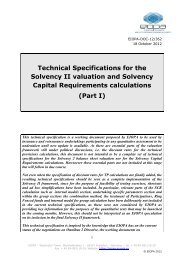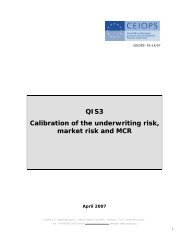Answers to the European Commission on the ... - Eiopa - Europa
Answers to the European Commission on the ... - Eiopa - Europa
Answers to the European Commission on the ... - Eiopa - Europa
Create successful ePaper yourself
Turn your PDF publications into a flip-book with our unique Google optimized e-Paper software.
Underwriting risk in n<strong>on</strong>-life insurance<br />
- Definiti<strong>on</strong> and main sub-risks<br />
10.66 Underwriting risk is <str<strong>on</strong>g>the</str<strong>on</strong>g> specific insurance risk arising from insurance<br />
c<strong>on</strong>tracts. These risks are based <strong>on</strong> <str<strong>on</strong>g>the</str<strong>on</strong>g> technicalities of <str<strong>on</strong>g>the</str<strong>on</strong>g> insurance<br />
business: <str<strong>on</strong>g>the</str<strong>on</strong>g> insurance undertaking has <str<strong>on</strong>g>to</str<strong>on</strong>g> ensure future payment<br />
commitments, and <str<strong>on</strong>g>the</str<strong>on</strong>g> volume of such payments must be calculated in<br />
advance.<br />
10.67 A distincti<strong>on</strong> can be drawn between:<br />
• reserve risk: relating <str<strong>on</strong>g>to</str<strong>on</strong>g> existing claims <strong>on</strong> coverage already<br />
provided; and<br />
• premium risk: relating <str<strong>on</strong>g>to</str<strong>on</strong>g> future claims arising from existing<br />
c<strong>on</strong>tracts and from renewals and new business during <str<strong>on</strong>g>the</str<strong>on</strong>g> time<br />
horiz<strong>on</strong><br />
10.68 Reserve risk stems from two sources: <strong>on</strong> <str<strong>on</strong>g>the</str<strong>on</strong>g> <strong>on</strong>e hand, <str<strong>on</strong>g>the</str<strong>on</strong>g> absolute<br />
level of <str<strong>on</strong>g>the</str<strong>on</strong>g> technical provisi<strong>on</strong>s may fail <str<strong>on</strong>g>to</str<strong>on</strong>g> reflect <str<strong>on</strong>g>the</str<strong>on</strong>g> true expected<br />
value of <str<strong>on</strong>g>to</str<strong>on</strong>g>tal losses and may <str<strong>on</strong>g>the</str<strong>on</strong>g>refore c<strong>on</strong>sistently underestimate <str<strong>on</strong>g>to</str<strong>on</strong>g>tal<br />
claim volumes. Alternatively, because of <str<strong>on</strong>g>the</str<strong>on</strong>g> s<str<strong>on</strong>g>to</str<strong>on</strong>g>chastic nature of future<br />
claim payouts, <str<strong>on</strong>g>the</str<strong>on</strong>g> actual claims will fluctuate around <str<strong>on</strong>g>the</str<strong>on</strong>g>ir statistical<br />
mean value. The need <str<strong>on</strong>g>to</str<strong>on</strong>g> address both sources depends <strong>on</strong> <str<strong>on</strong>g>the</str<strong>on</strong>g><br />
valuati<strong>on</strong> principles underlying <str<strong>on</strong>g>the</str<strong>on</strong>g> technical provisi<strong>on</strong>s. For example,<br />
under a best estimate approach, CEIOPS would implicitly assume that<br />
<str<strong>on</strong>g>the</str<strong>on</strong>g> first source of risk had been addressed (although clearly <str<strong>on</strong>g>the</str<strong>on</strong>g><br />
potential for estimati<strong>on</strong> error arising from <str<strong>on</strong>g>the</str<strong>on</strong>g> uncertainties in <str<strong>on</strong>g>the</str<strong>on</strong>g><br />
valuati<strong>on</strong> would still need <str<strong>on</strong>g>to</str<strong>on</strong>g> be c<strong>on</strong>sidered). The level of reserve risk<br />
should reduce as uncertainties are eliminated and informati<strong>on</strong> about<br />
<str<strong>on</strong>g>the</str<strong>on</strong>g> claims and <str<strong>on</strong>g>the</str<strong>on</strong>g>ir ultimate settlement costs become known.<br />
10.69 Premium risk is unders<str<strong>on</strong>g>to</str<strong>on</strong>g>od <str<strong>on</strong>g>to</str<strong>on</strong>g> relate <str<strong>on</strong>g>to</str<strong>on</strong>g> future claims arising during and<br />
after <str<strong>on</strong>g>the</str<strong>on</strong>g> time horiz<strong>on</strong> for <str<strong>on</strong>g>the</str<strong>on</strong>g> solvency assessment. Premium risk is<br />
present at <str<strong>on</strong>g>the</str<strong>on</strong>g> time <str<strong>on</strong>g>the</str<strong>on</strong>g> policy is issued, and before any insured events<br />
will have happened. The risk is that <str<strong>on</strong>g>the</str<strong>on</strong>g> volume of incurred losses for<br />
<str<strong>on</strong>g>the</str<strong>on</strong>g>se claims (comprising both losses paid during <str<strong>on</strong>g>the</str<strong>on</strong>g> time horiz<strong>on</strong> and<br />
provisi<strong>on</strong>s made at its end) plus expenses is higher than <str<strong>on</strong>g>the</str<strong>on</strong>g> premiums<br />
received. In assessing premium risk, both renewals and new business<br />
during <str<strong>on</strong>g>the</str<strong>on</strong>g> time horiz<strong>on</strong> should be incorporated.<br />
- Choice of structure for modelling approach <str<strong>on</strong>g>to</str<strong>on</strong>g> underwriting risk<br />
10.70 A scenario-based modelling approach <str<strong>on</strong>g>to</str<strong>on</strong>g> underwriting risk would require<br />
<str<strong>on</strong>g>the</str<strong>on</strong>g> definiti<strong>on</strong> of a set of scenarios that adequately describe any<br />
adverse development of <str<strong>on</strong>g>the</str<strong>on</strong>g> underwriting result of <str<strong>on</strong>g>the</str<strong>on</strong>g> insurers’<br />
portfolio. Given <str<strong>on</strong>g>the</str<strong>on</strong>g> heterogeneity of underwriting risk, even within<br />
established 'classes' of insurance business, <str<strong>on</strong>g>the</str<strong>on</strong>g> exclusive applicati<strong>on</strong> of<br />
such an approach does not seem feasible in <str<strong>on</strong>g>the</str<strong>on</strong>g> c<strong>on</strong>text of <str<strong>on</strong>g>the</str<strong>on</strong>g> standard<br />
formula.<br />
10.71 However, by nature of <str<strong>on</strong>g>the</str<strong>on</strong>g>ir c<strong>on</strong>structi<strong>on</strong>, fac<str<strong>on</strong>g>to</str<strong>on</strong>g>r-based models may be<br />
less able <str<strong>on</strong>g>to</str<strong>on</strong>g> predict extreme, catastrophic events, which c<strong>on</strong>stitute an<br />
95



